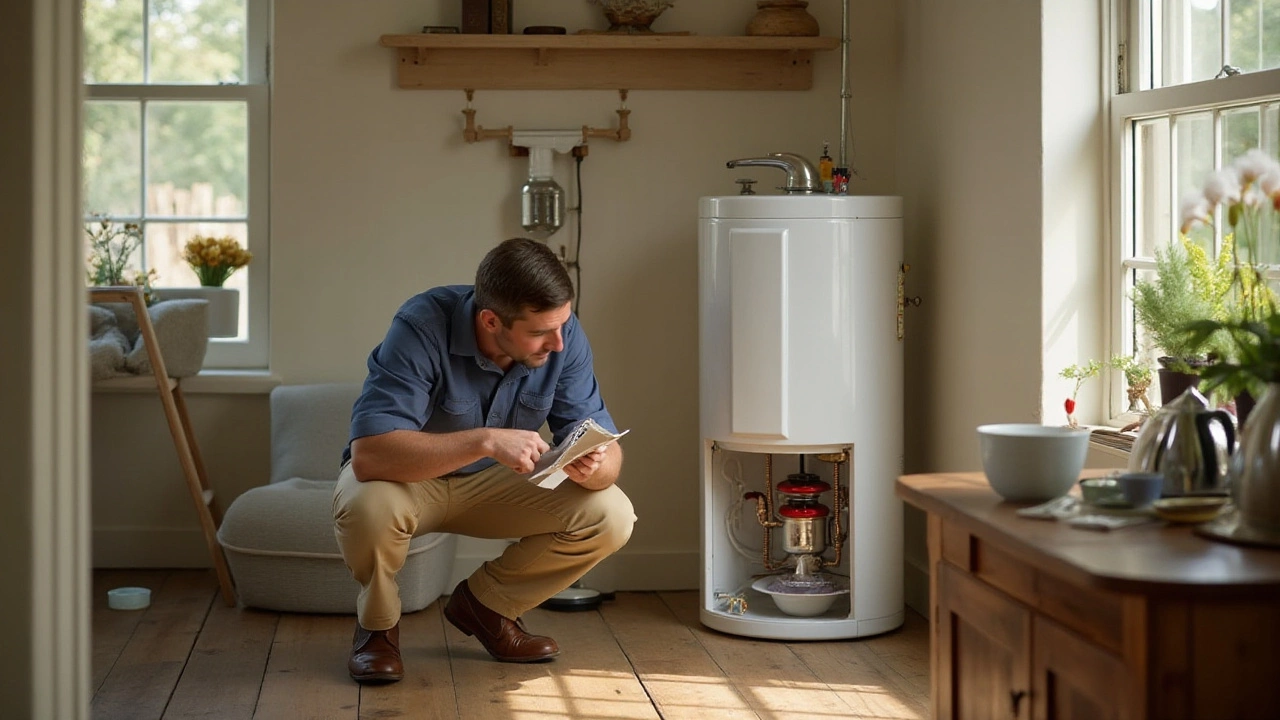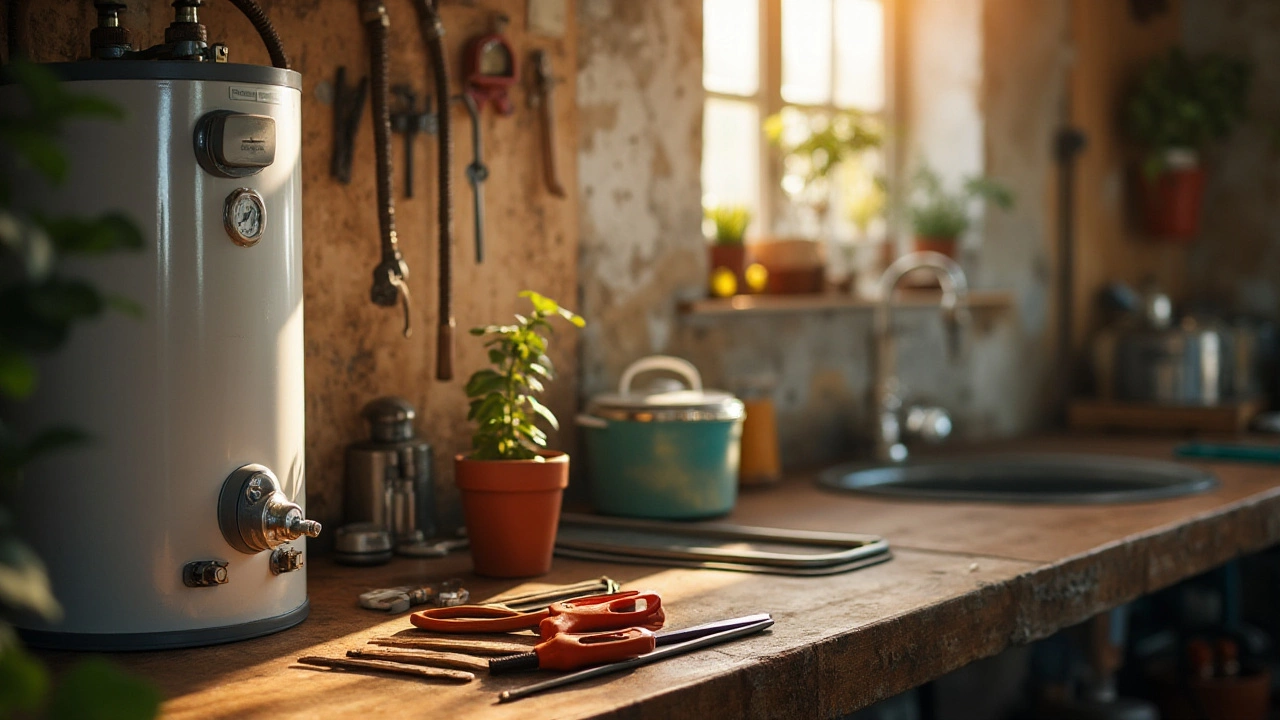Essential Tips for Water Heater Maintenance and Repair
 Nov, 8 2024
Nov, 8 2024
Water heaters are among the unsung heroes of our home, providing us with the luxury of warm baths and clean dishes. Yet they often go unnoticed until a problem arises. Giving your water heater the attention it deserves can spare you from unexpected cold showers and costly repairs. With some basic maintenance, you can ensure your water heater remains efficient and extends its lifespan, bringing peace of mind and savings.
It's not just about knowing when to call a professional; understanding the basics of maintenance can empower you to take small steps that make a big difference. By regularly inspecting, cleaning, and adjusting crucial components, you can keep your water heater running smoothly and efficiently for years to come.
- Importance of Regular Maintenance
- Inspecting and Replacing Anode Rod
- Flushing and Cleaning the Tank
- Understanding Temperature Settings
- Troubleshooting Common Issues
Importance of Regular Maintenance
We often overlook the myriad mechanical systems humming quietly in the background of our homes until a malfunction interrupts our routines. A water heater, in particular, plays a crucial role in everyday comfort, yet the benefits of regular maintenance are often underestimated. By taking a proactive approach, one can not only preserve the longevity of the appliance but enhance its efficiency too, which can lead to a noticeable reduction in energy bills. Regular upkeep also helps prevent the likelihood of catastrophic failures that can result in expensive repairs or replacements.
Imagine waking up to find your shower spewing lukewarm water instead of the soothing warmth you anticipated. This scenario is often a result of neglecting straightforward maintenance tasks such as sediment flushing, anode rod inspection, and temperature calibration. Neglecting these tasks can cause sediment buildup at the bottom of the tank, which then becomes a hard, crusty layer that can reduce the tank's energy efficiency and lead to overheating. When a water heater is kept in top condition, it is not only operating more efficiently but is also less likely to spring a disastrous leak.
According to the Department of Energy, water heating accounts for about 20% of a household's energy use. Proper maintenance—like setting the thermostat to 120 degrees Fahrenheit, according to experts—can save substantial energy annually, lowering your carbon footprint as well as your expenses. It's shocking how a task as simple as annually flushing your water heater can make such a massive difference. By removing sediments, you increase the appliance's heat transfer efficiency, making it easier and quicker to heat water while consuming less energy.
As Benjamin Franklin once wisely stated, "An ounce of prevention is worth a pound of cure." This timeless adage applies perfectly to water heater maintenance. By investing a little time and effort regularly, you can stave off significant issues down the line and experience fewer disruptions in your hot water service.
Moreover, many manufacturers make water heater warranties contingent on regular upkeep, and neglecting maintenance could potentially void the warranty. It's crucial to remain aware of these stipulations and the specifics included in the service guide.
Maintaining Peace of Mind
In the end, maintaining your water heater isn't just about the appliance—it's about maintaining the comfort of your home and ensuring the safety of your family. Water heaters are one of the most frequently used appliances, and regular maintenance acts like a reliable shield, protecting your home from inconveniences and unexpected expenses. So take heed, and keep this unsung hero in good working order.Inspecting and Replacing Anode Rod
Your water heater's anode rod acts as a vital shield against rust and corrosion. It's a metal rod made from either magnesium or aluminum wrapped around a steel core wire. Installed through the top of the tank, this sacrificial rod attracts corrosive elements in the water, keeping them away from the tank walls. Patience is key when figuring out if the anode rod needs replacing since it's your primary defense against tank decay. Water heater maintenance isn't only about keeping things warm—it's about prevention too.
Checking the condition of your anode rod is a task that may seem daunting, but it's quite straightforward once you get the hang of it. To do this, turn off the power supply or gas to your heater and shut off the water flow to the tank. Drain a few gallons of water from the tank for safety. Next, using a socket wrench, unscrew the rod, which is typically located at the top of the tank. If the rod is less than half an inch thick, or if it's coated with calcium, it's time to swap it out. Magnesium rods tend to corrode faster but condition the water better, making them a superior choice for water heater maintenance.
Choosing the Right Replacement
When it comes to replacing the anode rod, making the right choice is important. Magnesium rods, while more efficient, may get eroded faster in regions with hard water, so an aluminum rod might be the better substitute in such cases. Make sure to check your water's hardness. Installing a new anode isn't a Herculean task—follow the reverse order of the steps taken during removal. Tighten it carefully with a socket wrench to ensure a proper seal, but don't overdo it. A good seal will keep your heater running efficiently and prevent possible leaks, as securing your anode rod correctly exempts the tank from unnecessary strain.
"Regularly inspecting your water heater's anode rod can improve its lifespan by greatly reducing internal rust and corrosion." - Home Repair Expert
The frequency of your anode checks should ideally be once every two to three years. However, if your water has high mineral content, annual inspections are advisable. Keep a record of each inspection and replacement to establish a routine. Remember that neglecting an anode rod can cut the lifespan of your heater in half, making it crucial to prioritize this step in your water heater repair routine. Whether it's knowing when to call a tech or swapping out the anode rod yourself, taking charge of these plumbing basics can lead to significant savings.

Flushing and Cleaning the Tank
Regular flushing and cleaning of your water heater tank is a simple yet effective way to ensure its longevity and performance. Minerals like calcium and lime from your home's water supply can settle at the bottom of the tank, forming a sediment layer. This layer acts like an insulator between the water and the heating element, causing the heater to work harder and consume more energy. If left unchecked, this build-up not only reduces efficiency but can also lead to overheating or damage to the tank itself.
The process of flushing the tank involves draining out this water and sediment mix. Begin by turning off the power to your water heater—if it's electric, switch off the circuit breaker, and if it's gas-powered, turn the gas valve to the 'pilot' setting. Next, connect a garden hose to the drain valve found at the bottom of the unit. Ensure the other end of the hose is in a safe drainage area that can handle hot water, like a floor drain or outside. Open the pressure relief valve at the top of the tank to allow air into the system, then open the drain valve and let the water and sediment flow out completely.
Step-by-Step Guide
- Turn off the water supply to your heater and let it cool for safety.
- Attach a garden hose to the drain valve at the bottom.
- Ensure the other end of the hose is in a suitable draining area.
- Open the drain valve and let the water fully drain out.
- Once empty, open the cold water supply for a few minutes to further flush out stubborn sediments.
- Close the drain valve, remove the hose, and refill your tank with water.
- Turn the power back on or reignite the pilot light, and you're all set.
An important aspect to remember is periodicity. It's ideal to perform this maintenance task annually to prevent major build-ups. The frequency might vary depending on the hardness of your local water supply. According to a study conducted by the Water Quality Association, it’s noted that regions with extremely hard water might need more frequent flushing to maintain water heater efficiency. Scheduling this preventative measure prevents more expensive repairs down the road and keeps your system running smoothly.
"The more consistent the maintenance, the more efficient your appliance will be," says John Williams, a plumbing expert with over 25 years of experience.
Flushing and cleaning your tank is a straightforward task that can save significant costs over time. When you make this a part of your regular home maintenance routine, you're not only preserving your water heater but also ensuring you have a reliable supply of hot water. So, don’t skip this simple task. Your water heater will thank you with years of efficient service.
Understanding Temperature Settings
The temperature setting of your water heater may seem like a mere detail, but it holds a strong influence on both efficiency and safety in your home. When you start thinking about it, setting the right temperature impacts not just your comfort but also energy usage and safety. An optimal setting strikes a balance between these factors, ensuring you receive hot water without the associated risks or costs.
Most water heaters come preset at 140 degrees Fahrenheit, a level recommended by manufacturers for preventing harmful bacteria growth, like Legionella, which thrives in lukewarm water. However, the U.S. Department of Energy suggests setting your water heater to 120 degrees Fahrenheit to maximize energy efficiency and reduce scalding risks. Each degree higher uses more energy, about four percent more, which can inflate your heating bills over time. Balancing this aspect requires consideration of the number of people in the house, their usage habits, and specific health conditions that might necessitate a higher baseline temperature.
Adjusting the temperature on your water heater is usually simple. Most units have a visible thermostat accessible on the heater. Before making changes, turn off the power to your electric heater or set the gas control valve to “pilot” mode. For an electric heater, remove the thermostat panel cover carefully, keeping in mind insulation might need to be unveiled. Use a flat screwdriver to gently turn the thermostat dial to your desired setting. Once ready, replace the panel, restore power, and let the system stabilize.
Effects of Temperature Changes
Changing the temperature isn't just about rotating a dial. It sets off a chain reaction influencing energy usage and lifespan of the appliance. Consistently high temperatures can cause premature wear on components due to increased pressure inside the tank. Over time, this might lead to leaks and the need for repair. On the flip side of this scenario, setting temperatures too low sacrifices the vital sterilization of pipes, risking bacteria development. This delicate balancing act makes knowing and adjusting your settings crucial.
In terms of user experiences, it is beneficial to consider everyone in your household. For family settings with kids or elderly individuals, safety becomes a priority. To mitigate scalding risks, the aforementioned 120 degrees is recommended. Interestingly, a study by the American Burn Association highlighted that water at 140 degrees can cause a third-degree burn in just five seconds, while at 120 degrees, it takes around five minutes.
"Hot water safety is crucial in every home. Understanding the interplay between temperature and safety can prevent serious accidents," says Dr. Michelle Cunningham from the Safety Institute.
Knowing your water heater, its make, and model also plays a role. Newer models sometimes offer automated technology that maintains balance without manual adjustments. If your water heater features a smart thermostat, you can program it around peak usage times, reducing unnecessary heating when hot water is not needed. For those aiming for energy efficiency, utilizing these features lets you save without compromising comfort.

Troubleshooting Common Issues
Everybody dreads stepping into a shower only to be greeted by a chilling blast instead of the expected warmth. A water heater has straightforward tasks, yet can occasionally falter. When it does, knowing how to troubleshoot common issues can save lots of frustrations and possibly a service call. Imagine coming home after a long day, just to find your hot water supply kaput; suddenly, you're in DIY mode. First, if the water isn’t hot enough, it may be due to a faulty thermostat or heating element. Check the thermostat temperature setting and ensure it's around 120 degrees Fahrenheit. This setting offers enough heat for daily needs without wasting energy. If the issue persists, inspect and test the heating element, which can often burn out over time.
Next, sometimes you may encounter discolored or rusty water, which might make you wonder if your pipes have taken a turn for the worse. This usually points to corrosion within the tank, especially if you have an older model. Being proactive is key here—checking the anode rod and replacing it if more than 6 inches of the core wire is exposed can prevent rust from forming inside your tank. Don’t let rust become a more significant headache down the line!
Strange Noises
Bizarre noises, such as popping or rumbling, coming from your water heater are never comforting. Though your appliances can seem possessed, often these sounds are due to sediment build-up at the base of the tank. When heated, this sediment causes the noises. Flushing your tank annually helps remove these sediment layers, prolonging your water heater's lifespan and enhances its efficiency. Not to forget, draining the tank and refilling it until sediment is removed can do wonders.
Leaks Around the Base
Spotting a pool of water by your heater’s base is another unsettling sight. Investigating the source is crucial. Check for loose connections in pipes and valves first. If found intact, the culprit may be the tank itself, indicating it’s time for a replacement. A repair isn’t likely without compromising safety due to the pressure and temperature involved. Investing in a new tank assures safety and efficiency in such cases. If need be, calling a professional at this stage is wise.
For households conscious of energy and budget, ensuring your water heater repair needs are minimal means taking note of your heater’s performance regularly. As energy expert Laura Fischer once stated,
"Regular inspections not only extend a water heater’s life but create an opportunity for homeowners to reduce energy consumption significantly."It sure makes sense when every little counts towards efficiency and savings. If armed with the right knowledge, maintaining and troubleshooting your water heater can be a smooth — if not empowering — part of home ownership.
